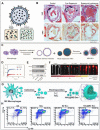Tuning macrophages for atherosclerosis treatment
- PMID: 36683743
- PMCID: PMC9845526
- DOI: 10.1093/rb/rbac103
Tuning macrophages for atherosclerosis treatment
Abstract
Atherosclerosis is a chronic inflammatory vascular disease and a leading cause of death worldwide. Macrophages play an important role in inflammatory responses, cell-cell communications, plaque growth and plaque rupture in atherosclerotic lesions. Here, we review the sources, functions and complex phenotypes of macrophages in the progression of atherosclerosis, and discuss the recent approaches in modulating macrophage phenotype and autophagy for atherosclerosis treatment. We then focus on the drug delivery strategies that target macrophages or use macrophage membrane-coated particles to deliver therapeutics to the lesion sites. These biomaterial-based approaches that target, modulate or engineer macrophages have broad applications for disease therapies and tissue regeneration.
Keywords: atherosclerosis; drug delivery system; immune engineering; macrophages.
© The Author(s) 2022. Published by Oxford University Press.
Figures






Similar articles
-
Understanding the role of alternative macrophage phenotypes in human atherosclerosis.Expert Rev Cardiovasc Ther. 2022 Sep;20(9):689-705. doi: 10.1080/14779072.2022.2111301. Epub 2022 Aug 10. Expert Rev Cardiovasc Ther. 2022. PMID: 35942866
-
New Targets in Atherosclerosis: Vascular Smooth Muscle Cell Plasticity and Macrophage Polarity.Clin Ther. 2023 Nov;45(11):1047-1054. doi: 10.1016/j.clinthera.2023.08.015. Epub 2023 Sep 13. Clin Ther. 2023. PMID: 37709601 Review.
-
The Role of Macrophages in Atherosclerosis: Pathophysiologic Mechanisms and Treatment Considerations.Int J Mol Sci. 2023 May 31;24(11):9568. doi: 10.3390/ijms24119568. Int J Mol Sci. 2023. PMID: 37298518 Free PMC article. Review.
-
Targeting macrophages using nanoparticles: a potential therapeutic strategy for atherosclerosis.J Mater Chem B. 2021 Apr 21;9(15):3284-3294. doi: 10.1039/d0tb02956d. Epub 2021 Mar 30. J Mater Chem B. 2021. PMID: 33881414 Review.
-
Vascular Macrophages in Atherosclerosis.J Immunol Res. 2019 Dec 1;2019:4354786. doi: 10.1155/2019/4354786. eCollection 2019. J Immunol Res. 2019. PMID: 31886303 Free PMC article. Review.
Cited by
-
A strategy for mechanically integrating robust hydrogel-tissue hybrid to promote the anti-calcification and endothelialization of bioprosthetic heart valve.Regen Biomater. 2024 Jan 30;11:rbae003. doi: 10.1093/rb/rbae003. eCollection 2024. Regen Biomater. 2024. PMID: 38414796 Free PMC article.
-
CD47-SIRPα signaling-inspired engineered monocytes for preventing the progression of atherosclerotic plaques.Mater Today Bio. 2024 Aug 2;28:101178. doi: 10.1016/j.mtbio.2024.101178. eCollection 2024 Oct. Mater Today Bio. 2024. PMID: 39211288 Free PMC article.
-
Qingre Huoxue Decoction Alleviates Atherosclerosis by Regulating Macrophage Polarization Through Exosomal miR-26a-5p.Drug Des Devel Ther. 2024 Dec 28;18:6389-6411. doi: 10.2147/DDDT.S487476. eCollection 2024. Drug Des Devel Ther. 2024. PMID: 39749190 Free PMC article.
-
Single-Cell Atlas of Atherosclerosis Patients by Cytof: Circulatory and Local Immune Disorders.Aging Dis. 2024 Feb 1;15(1):245-258. doi: 10.14336/AD.2023.0426-1. Aging Dis. 2024. PMID: 37307820 Free PMC article.
-
Lipid-laden foam cells in the pathology of atherosclerosis: shedding light on new therapeutic targets.Expert Opin Ther Targets. 2023 Jul-Dec;27(12):1231-1245. doi: 10.1080/14728222.2023.2288272. Epub 2023 Dec 30. Expert Opin Ther Targets. 2023. PMID: 38009300 Free PMC article. Review.
References
Publication types
Grants and funding
LinkOut - more resources
Full Text Sources

